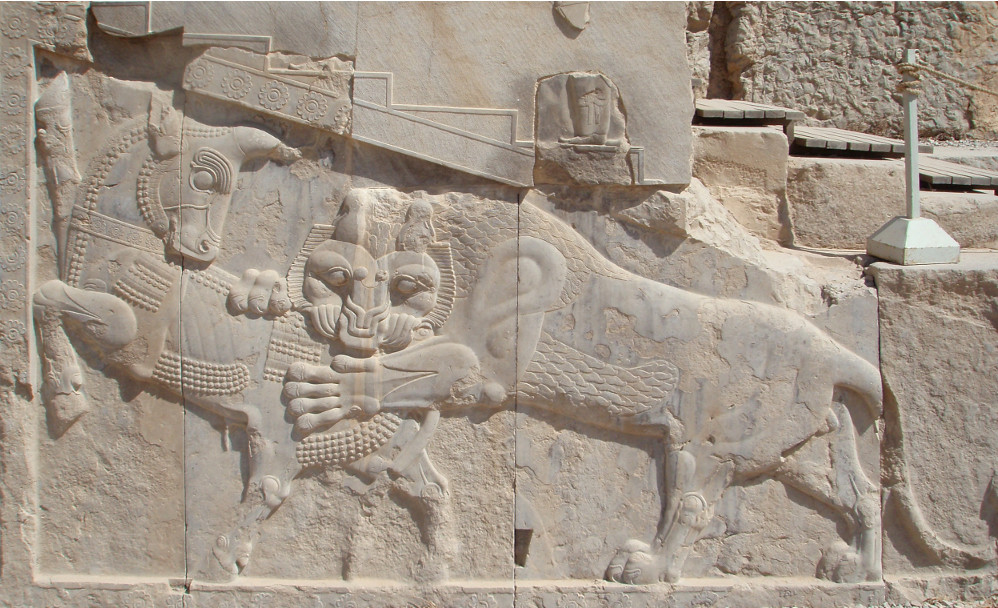Persian mythology are traditional tales and stories of ancient origin, all involving extraordinary or supernatural beings. Drawn from the legendary past of Iran, they reflect the attitudes of the society to which they first belonged – attitudes towards the confrontation of good and evil, the actions of the gods, yazats (lesser gods), and the exploits of heroes and fabulous creatures. Myths play a crucial part in Iranian culture and our understanding of them is increased when we consider them within the context of Iranian history.
For this purpose we must ignore modern political boundaries and look at historical developments in the Greater Iran, a vast area covering the Caucasus, and Central Asia, beyond the frontiers of present-day Iran. The geography of this region, with its high mountain ranges, plays a significant role in many of the mythological stories. The second millennium BCE is usually regarded as the age of migration because of the emergence in western Iran of a new form of Iranian pottery, similar to earlier wares of north-eastern Iran, suggesting the arrival of the Ancient Iranian peoples. This pottery, light grey to black in color, appeared around 1400 BCE. It is called Early Grey Ware or Iron I, the latter name indicating the beginning of the Iron Age in this area.
Key texts
The central collection of Persian mythology is the Shahnameh of Ferdowsi, written over a thousand years ago. Ferdowsi’s work draws heavily, with attribution, on the stories and characters of Mazdaism and Zoroastrianism, not only from the Avesta, but from later texts such as the Bundahishn and the Denkard as well as many others.
Religious background
The characters of Persian mythology almost always fall into one of two camps. They are either good, or they are evil. The resultant discord mirrors the ancient conflict, which in Persian mythology is based on the Zoroastrian concept of the dual emanation of Ahura Mazda (Avestan, or Ormuzd in later Persian). Spenta Mainyu is the source of constructive energy, while Angra Mainyu is the source of darkness, destruction, sterility, and death.
Found in abundance in Persian mythology are the daēva (Avestan, Persian: div), meaning ‘celestial’ or ‘bright’. These divinities were worshipped in pre-Zoroastrian Mazdaism, and as in Vedic religions, the adherents of the pre-Zoroastrian form of Mazdaism considered the daēva holy and sacred beings. It is only after the religious reforms of Zarathustra (Zoroaster) that the term daēva became associated with demons. Even then the Persians living south of the Caspian Sea continued to worship the daeva and resisted pressure to accept Zoroastrianism, and legends that involve daēva survive to this day. For instance, that of the legend of the Div-e Sepid (white daēva) of Mazandaran.
Moreover, Angra Mainyu or Ahriman in Persian, once the Zoroastrian epitome of evil, lost its original Zoroastrian/Mazdaist identity in later Persian literature, and was ultimately depicted as a div. Religious depictions of Ahriman made in the era following the Islamic invasion show Ahriman as a giant of a man with spotted body and two horns.
Good and Evil
The most famous legendary character in the Persian epics and mythology is Rostam. On the other side of the fence is Zahhak, a symbol of despotism who was, finally, defeated by Kaveh the Blacksmith who led a popular uprising against him. Zahhak (Aži Dahāka) was guarded by two vipers which grew out from both of his shoulders. No matter how many times they were beheaded, new heads grew on them to guard him. The snake, like in many other mythologies, was a symbol of evil, but many other animals and birds appear in Iranian mythology, and, especially, the birds were signs of good omen. Most famous of these is Simorgh, a large beautiful and powerful bird; and Homa, a royal bird of victory whose plume adorned the crowns.
Peri (Avestan: Pairika), considered a beautiful though evil woman in early mythology, gradually became less evil and more beautiful, until the Islamic period she became a symbol of beauty similar to the houris of Paradise.



Comment